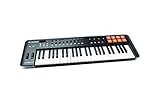Best MIDI Keyboard Under $200: Complete Reviews With Comparisons

All you need to create music nowadays is a computer with an application that produces, tweaks, mixes, and records sounds.
Nevertheless, a computer keyboard only offers very simulated controls that cannot even vaguely match the reactiveness of melodious piano keys.
Fortunately, music producers like yourself can combine software on a computer with highly expressive features of MIDI keyboards.
Still, you might be hesitant about creating music with a MIDI device because of the hefty price tags that come with them.
We’re here to help you cut down costs and narrow down your search with the best MIDI keyboards under 200 dollars.
Comparison Chart
MIDI Keyboard Under $200 Reviews
1. Akai Professional MPK Mini MKII
Anyone planning to jumpstart their studio-producing hobby or professional career without breaking the bank can definitely benefit from the Akai Pro MPK Mini MKII.
Its all-new, enhanced design incorporates five years of user feedback, essentially piling up into a popular feature set.
Because of this basis for design, its keyboard and drum pad combo makes it a beginner producer’s dream MIDI controller.
Review
The MPK Mini MKII has Akai Pro’s signature black and red color scheme for the MPK Mini Series.
While it features a primarily black finish, its side panels are bright red, and the buttons have red backlighting.
The MPK Mini MKII measures 12.5 by 7.3 by 1.75 inches and weighs 1.65 pounds.
This Akai midi keyboard is small enough to fit into a backpack without sacrificing the versatility of MIDI controls.
- Control Features
Now, let’s go over the control features of the MPK Mini MKII one by one.
Its keyboard sports 25 velocity-sensitive, synth-action mini-keys and boasts a 10-octave range with the help of the octave up and down buttons.
These keys have names right above them on the top panel. Each of the labels designates an arpeggiator function for every key.
The MPK Mini MKII has a red four-way thumbstick on its upper left corner for dynamic modulation and pitch control.
It also features eight trigger pads and eight encoder knobs at the top panel.
You can use the pads to trigger drum sounds or other preset samples in your digital audio workstation (DAW) software.
Each of the eight knobs offers a 270-degree turn for sending MIDI control change (CC) messages.
Additional controls include arpeggiator On/Off, Tap Tempo, Full Level, Note Repeat, Bank, CC, Prog Change, and Prog Select.
As you can see, the MPK Mini MKII is compact and lightweight, but it does not hold back on functionality.
- Connectivity Features
The MPK Mini MKII has a USB port on its right side for sending and receiving MIDI data to and from your computer.
A standard USB cable also functions as the primary power connector of the device, as it draws power from your computer.
Additionally, a 1/4-inch TS jack on the rear allows an input connection for a sustain pedal.
PROS
CONS
2. Alesis VI25
If you can spend a little more, the Alesis VI25 can offer more controls than the Akai Pro MPK Mini MKII.
It is an advanced USB/MIDI keyboard controller that features seamless visual feedback through its LED screen and illuminated controls.
Review
While the MPK Series sports Akai Pro’s black and red theme, the VI25 accentuates the black and blue color scheme of Alesis’ keyboard controllers.
Its buttons and knobs feature blue backlighting, and the trigger pads expand functionality with red, green, and blue changing colors.
The Alesis VI25 measures 24.6 by 12.4 by 4.5 inches and weighs 7.0 pounds.
It is not as portable as the Akai Pro MPK Mini MKII, and it wouldn’t fit in a standard backpack.
However, it still offers some portability for someone looking to purchase a device with pro-grade controls.
- Control Features
Unlike the MPK Mini MKII, the Alesis VI25 features 25 full-sized, velocity- and pressure-sensitive piano keys.
Two Octave buttons allow these keys to access a full range of 127 available MIDI notes.
The left side has 16 trigger pads and two analog wheels. You can use the pads to trigger drum beats or software presets on an external MIDI sound module.
All the trigger pads are velocity-sensitive and have RGB lighting for feedback, making them very responsive and intuitive to play.
Moreover, the two analog blue-backlit wheels enable you to deliver expressive and creative pitch bend and modulation inputs.
Other assignable controls include 24 backlit buttons and eight knobs that can interface with your music software or an external MIDI device.
You can send MIDI CC messages using the momentary or latching features of the 24 buttons and the 270-degree turn of the eight knobs.
Additional controls on this Alesis midi keyboard include six Transport buttons, Tempo, Roll, and Preset Up and Down buttons.
Finally, an LCD screen right beside the Alesis logo allows you to view parameter values relevant to the device’s current operation.
These controls are thoughtfully laid out on the board, giving any user the convenience of creating music without erroneously hitting a key.
- Connectivity Features
The Alesis VI25 has four ports at the rear panel along with the main power switch.
A power input port allows a 9V DC power supply connection that enables the Alesis VI25 for standalone applications.
The device has a MIDI Out port that lets you make a slave out of another external MIDI device.
Alternatively, you can let the VI25 draw power directly from a computer using the USB port.
This port also functions as the main data transfer node for sending and receiving MIDI messages to and from a computer.
You can also connect a sustain pedal using the 1/4-inch sustain input jack.
PROS
CONS
3. Arturia KeyStep-37
The Arturia KeyStep-37 is a deluxe version of the classic and lower-priced 32-key KeyStep.
It improves on the KeyStep-32’s key count and adds more MIDI CC functions and advanced chord and scale controls.
While most MIDI keyboards focus on controlling DAW software, the Arturia KeyStep-37 takes a unique approach towards playing more and generating musical ideas.
Review
Unlike all the other alternatives presented here, the KeyStep-37 features a primarily white color scheme.
Black controls include the knobs, a Shift button, an Arpeggiator switch, a Chord button, and the flat and sharp keys.
The black color of these controls enables them to be easily seen and accessible during music production sessions.
The Arturia KeyStep-37 measures 21.7 by 5.78 by 1.38 inches and weighs 3.5 pounds.
Its weight and dimensions make it more compact and more portable than the Alesis VI25.
- Control Features
The Arturia KeyStep-37 has a Slimkey keybed with 37 mini-keys having velocity and pressure sensitivity.
The 37 great-feeling keys are smaller than standard piano keys, but they are large enough to enable maximum playability.
It also has two Octave buttons for transposition and two touch strips for pitch bend and modulation.
Additional controls include a Hold/Sustain button and a Shift button.
Since the Arturia KeyStep-37 focuses on generating unique musical inputs, it does not have any sliders or trigger pads.
- Connectivity Features
What the KeyStep-37 lacks in control features is offset by its comprehensive connectivity features.
You can use the KeyStep-37 to control other MIDI devices, or you can control it using other MIDI controllers.
The rear panel has the main switch, a 12-volt DC adapter jack, a USB port, a sustain jack, MIDI In and Out ports, and Sync Input and Output for pre-MIDI devices.
It also has three Control Voltage (CV) Output jacks for Pitch, Gate, and Modulation.
A synchronization slider switch also allows you to select between four sync options, including Internal, USB, MIDI, and Sync In connections.
PROS
CONS
4. M-Audio Oxygen-49 MKIV
With continuous innovation taking place for almost a decade, the M-Audio Oxygen Series offers better control and deeper hardware and software integration.
The Oxygen-49 MKIV comes with a reliable build perfect for on-the-go music and studio implementations.
It provides you with streamlined control and lets you use your favorite DAWs for sound creation and music production.
Review
The M-Audio Oxygen-49 MKIV has a simple, primarily black color scheme with orange-backlit trigger pads.
It measures 32 by 9.6 by 3.7 inches and weighs 6.4 pounds. Albeit being longer and bulkier than the Alesis VI25, it weighs slightly lighter.
In comparison, the Oxygen-49 MKIV presents easier access to all of the basic controls a MIDI controller can have.
- Control Features
The Oxygen-49 MKIV has 49 full-sized, velocity-sensitive, synth-action keys.
You will find names corresponding to each key along the upper edge of the keyboard.
These labels designate each key for accessing extended programming functions with the Shift function key.
This M-Audio midi keyboard also has eight velocity-sensitive trigger pads, eight encoder knobs, nine faders, and nine mappable control buttons.
Additional control features include a three-digit LED screen, six function selection buttons, octave plus and minus buttons, and pitch bend and modulation wheels.
For Transport control, the Oxygen-49 MKIV has four transport buttons for MIDI CC, MIDI note, MMC, and other advanced MIDI functions.
- Connectivity Features
The rear panel of the Oxygen-49 MKIV has a USB port, a sustain pedal jack, the main power switch, and a Kensington lock slot.
Like the Akai Pro MPK Mini MKII, the Oxygen-49 MKIV draws power from a computer while sending and receiving data through the USB connection.
PROS
CONS
5. Nektar Impact GX61
If 49 keys are not enough and you want to keep your budget below 200 bucks, the Nektar Impact GX61 might just be what you need.
It offers improved performance with computer music systems without requiring a complicated setup.
Review
The Impact GX61 features a very simple black and white color scheme, similar to the Oxygen 49-MKIV.
However, it focuses more on delivering unique musical inputs using more piano-style keys than knobs, sliders, and trigger pads.
The Impact GX61 measures 38 by 7.75 by 2.75 inches, making it the largest device in this selection.
Still, this Nektar midi keyboard only weighs a mere six pounds for its size, so it’s even lighter than the Alesis VI25 and the Oxygen-49 MKIV.
- Control Features
The Nektar Impact GX61 features a 61-note, full-size, velocity-sensitive keyboard with four velocity curves and three fixed velocity settings.
With the variable velocity settings, you can either be exceptionally expressive or highly precise with your inputs.
The left side of the Impact GX61 has an assignable knob that works as a potentiometer and two wheels for pitch bend and modulation.
It also has 13 buttons: Setup, Shift, Octave Up, Octave Down, Transpose Up, Transpose Down, and seven Transport buttons.
The seven Transport buttons have a secondary control level that enables them to function as 14 different MIDI controls.
- Connectivity Features
The rear panel of the Impact GX61 has a USB port, a 1/4-inch TS jack for a MIDI-assignable footswitch input, and the main power switch.
Data transfers and power draws go through the USB port, and there are no 5-pin MIDI connectors.
PROS
CONS
Which Is the Top MIDI Keyboard Below 200 Dollars?
For anyone on a tight budget looking for portability and a wide range of functions, we suggest going for the Akai Pro MPK Mini MKII.
It is sleek and small, and it delivers the functionality of other more expensive MIDI controllers.
Conversely, having a little more to spend means you can have the more straightforward functions available to the Alesis VI25.
If the top MIDI keyboard under 200 bucks still doesn’t fit your budget, you might want to look at our selection of MIDI controllers under 100 dollars.














